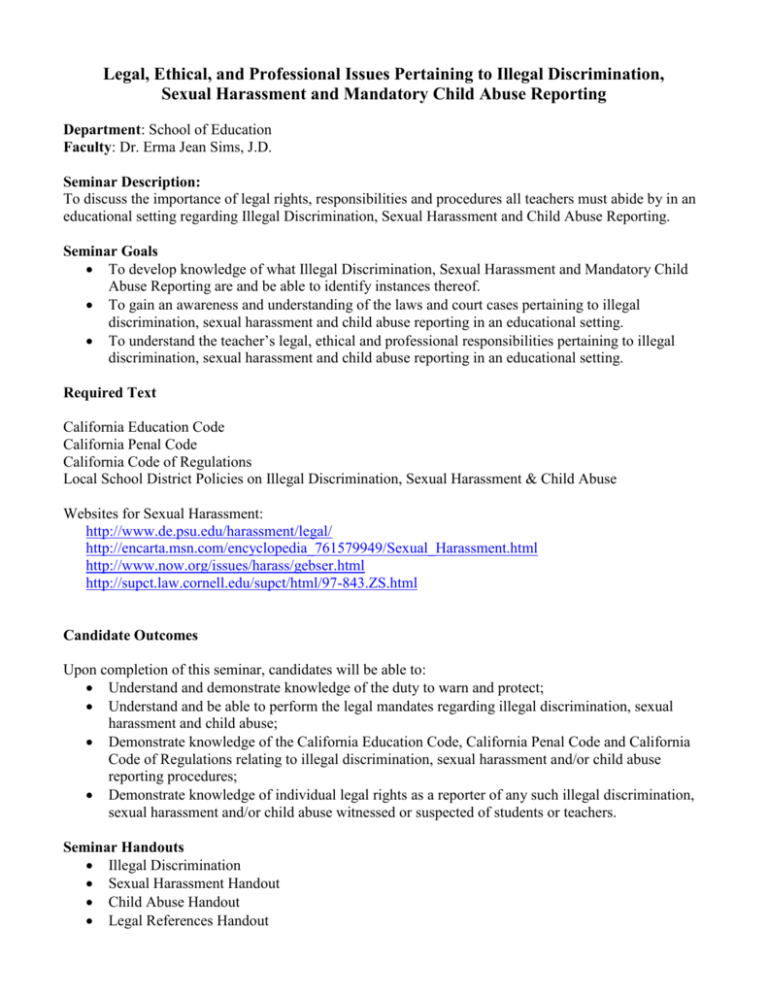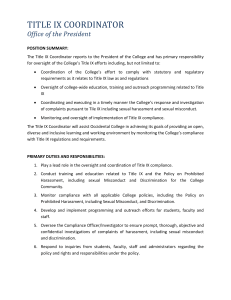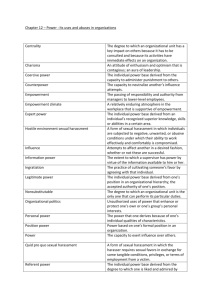
Legal, Ethical, and Professional Issues Pertaining to Illegal Discrimination,
Sexual Harassment and Mandatory Child Abuse Reporting
Department: School of Education
Faculty: Dr. Erma Jean Sims, J.D.
Seminar Description:
To discuss the importance of legal rights, responsibilities and procedures all teachers must abide by in an
educational setting regarding Illegal Discrimination, Sexual Harassment and Child Abuse Reporting.
Seminar Goals
To develop knowledge of what Illegal Discrimination, Sexual Harassment and Mandatory Child
Abuse Reporting are and be able to identify instances thereof.
To gain an awareness and understanding of the laws and court cases pertaining to illegal
discrimination, sexual harassment and child abuse reporting in an educational setting.
To understand the teacher’s legal, ethical and professional responsibilities pertaining to illegal
discrimination, sexual harassment and child abuse reporting in an educational setting.
Required Text
California Education Code
California Penal Code
California Code of Regulations
Local School District Policies on Illegal Discrimination, Sexual Harassment & Child Abuse
Websites for Sexual Harassment:
http://www.de.psu.edu/harassment/legal/
http://encarta.msn.com/encyclopedia_761579949/Sexual_Harassment.html
http://www.now.org/issues/harass/gebser.html
http://supct.law.cornell.edu/supct/html/97-843.ZS.html
Candidate Outcomes
Upon completion of this seminar, candidates will be able to:
Understand and demonstrate knowledge of the duty to warn and protect;
Understand and be able to perform the legal mandates regarding illegal discrimination, sexual
harassment and child abuse;
Demonstrate knowledge of the California Education Code, California Penal Code and California
Code of Regulations relating to illegal discrimination, sexual harassment and/or child abuse
reporting procedures;
Demonstrate knowledge of individual legal rights as a reporter of any such illegal discrimination,
sexual harassment and/or child abuse witnessed or suspected of students or teachers.
Seminar Handouts
Illegal Discrimination
Sexual Harassment Handout
Child Abuse Handout
Legal References Handout
Legal References
California Commission on Teacher Credentialing
TPE 12: Professional, Legal, and Ethical Obligations
Sexual Harassment References
California Education Code
Section 212.5 Sexual harassment, defined
Section 230 Particular Practices prohibited
California Code of Regulations
CCR 80337
Websites
http://www.de.psu.edu/harassment/legal/
http://encarta.msn.com/encyclopedia_761579949/Sexual_Harassment.html
http://www.now.org/issues/harass/gebser.html
http://supct.law.cornell.edu/supct/html/97-843.ZS.html
Child Abuse References:
California Education Code
Section 33308.1 - Guidelines on procedure for filing child abuse complaints
Section 44690-44691 - Staff Development in the detection of child abuse and complaint
Section 48906 - Notification when student released to peace officer
California Penal Code
Section 273a Willful cruelty or unjustifiable punishment of child; endangering life or health
Section 11164-11174.3 Child Abuse and Neglect Reporting Act
Section 11165-11165.15 Definitions relating to child abuse
Section 11166-11170 Reporting known or suspected cases of child abuse
Section 11172 Immunity from liability
Illegal Discrimination:
California Education Code
Section 200 illegal discrimination
California Code of Regulations
80338 Discrimination, prohibited.
California Penal Code
Section 422.55 illegal discrimination
Illegal Discrimination, Sexual Harassment and
Mandatory Child Abuse Reporting Legal Seminar
Presented by: Dr. Erma Jean Sims, J.D. – Sonoma State University
I. INTRO/ IMPORTANCE
It is important that teachers know and understand their legal, ethical and professional obligations
pertaining to illegal discrimination, sexual harassment and mandatory child abuse reporting within
an educational setting. – (See TPE 12)
II. ILLEGAL DISCRIMINATION
A. Definition
B. Legal Responsibility and Liability
III. SEXUAL HARASSMENT
B. Definition
C. Court Decisions
I.
II.
1999 Supreme Court Case: Davis, as next friend of LaShonda D v. Monroe County
Board of Education et al.
1998 Supreme Court Case: Gebser v. Lago Vista Independent School District
D. Typical Examples
E. Scenarios & Questions for Discussion
IV. MANDATORY REPORTING OF ABUSE
A. Definition
B. Documentation
I.
Reporting Procedures
II.
Legal Responsibility and Liability
III.
When School Employees are Accused of Child Abuse
C. Typical Examples
D. Scenarios & Questions for Discussion
V. FREQUENTLY ASKED QUESTIONS
VI. LEGAL REFERENCES
ILLEGAL DISCRIMINATION HANDOUT
California Code of Regulations
80338 Discrimination Prohibited.
A certificated person shall not, without good cause, in the course and scope of his or her certificated
employment and solely because of race, color, creed, gender, national origin, handicapping condition or
sexual orientation, refuse or fail to perform certificated services for any person.
California Education Code
Section 200
It is the policy of the State of California to afford all persons in public schools, regardless of their sex,
ethnic group identification, race, national origin, religion, mental or physical disability, or regardless of
any actual or perceived characteristic that is contained in the definition of hate crimes set forth in Section
422.55 of the Penal Code, equal rights and opportunities in the educational institutions of the state. The
purpose of this chapter is to prohibit acts which are contrary to that policy and to provide remedies
therefor.
California Penal Code
Section 422.55.
For purposes of this title, and for purposes of all other state law unless an explicit provision of law or the
context clearly requires a different meaning, the following shall apply:
(a) "Hate crime" means a criminal act committed, in whole or in part, because of one or more
of the following actual or perceived characteristics of the victim:
(1) Disability.
(2) Gender.
(3) Nationality.
(4) Race or ethnicity.
(5) Religion.
(6) Sexual orientation.
(7) Association with a person or group with one or more of these actual or perceived
characteristics.
SEXUAL HARASSMENT HANDOUT
DEFINITION:
Unwanted verbal or physical behavior of a sexual nature that makes someone feel uncomfortable or
unwelcome that occurs in the workplace or in an educational setting.
Such behavior is illegal if it creates a hostile or intimidating environment, if it interferes with an
individual’s work or school performance, or if acceptance of the harasser’s behavior is made a
condition of employment or academic achievement.
California Education Code
Section 212.5.
"Sexual harassment" means unwelcome sexual advances, requests for sexual favors, and other verbal,
visual, or physical conduct of a sexual nature, made by someone from or in the work or educational
setting, under any of the following conditions:
(a) Submission to the conduct is explicitly or implicitly made a
term or a condition of an individual's employment, academic status,
or progress.
(b) Submission to, or rejection of, the conduct by the individual
is used as the basis of employment or academic decisions affecting
the individual.
(c) The conduct has the purpose or effect of having a negative
impact upon the individual's work or academic performance, or of
creating an intimidating, hostile, or offensive work or educational
environment.
(d) Submission to, or rejection of, the conduct by the individual
is used as the basis for any decision affecting the individual
regarding benefits and services, honors, programs, or activities
available at or through the educational institution.
California Code of Regulations
80377 - Sexual Harassment and Retaliation Prohibited
No certificated person shall directly or indirectly use or threaten to use any official authority or influence
in any manner whatsoever which tends to discourage, restrain, interfere with, coerce, or discriminate
against any subordinate or any certificated person who in good faith reports, discloses, divulges, or
otherwise brings to the attention of the governing board of a school district, the Commission on Teacher
Credentialing or any other public agency authorized to take remedial action, any facts or information
relative to actual or suspected violation of any law regulating the duties of persons serving in the public
school system, including but not limited to these rules of professional conduct.
Examples of other types of conduct that are prohibited in many school districts and which may
constitute sexual harassment include:
1. Unwelcome leering, sexual flirtations or propositions.
2. Unwelcome sexual slurs, epithets, threats, verbal abuse, derogatory comments or sexually
degrading descriptions.
3. Graphic verbal comments about an individual’s body, or overly personal conversation.
4. Sexual jokes, stories, drawings, pictures, or gestures.
5. Spreading sexual rumors.
6. Teasing or sexual remarks about students enrolled in a predominantly single-sex class.
7. Touching an individual's body or clothes in a sexual way.
8. Purposefully limiting a student's access to educational tools.
9. Cornering or blocking of normal movements.
10. Displaying sexually suggestive objects in the educational environment.
11. Any act of retaliation against an individual who reports a violation of the district's sexual
harassment policy or who participates in the investigation of a sexual harassment complaint.
Certificated School Personnel Responsibilities
It is the teacher’s responsibility to take appropriate actions to prevent and report incidents of sexual
harassment to their school site administration. Be sure to consult and follow your school district’s
policies and procedures on sexual harassment.
Suggested Reporting Procedures Guidelines
Keep accurate and detailed records of the sexual harassment incident.
Report sexual harassment to the appropriate person at your school site.
Follow your school district’s policies and procedures on sexual harassment reporting.
CHILD ABUSE HANDOUT
DEFINITION:
1. A physical injury inflicted, not by accident, on a child by another person
2. Sexual abuse of a child
3. Willful cruelty or unjustifiable punishment of a child, or willfully inflicting unjustifiable physical pain
or mental suffering, or failure to safeguard a child from these injuries when the child is under a
person’s care or custody
4. Unlawful corporal punishment or injury resulting in a traumatic condition
5. Neglect of a child or abuse in out-of-home care
Mandated Reporters of Child Abuse
“Mandated Reporters” include virtually all school employees. The following school personnel are
required to report:
Teachers, administrators, supervisors of child welfare and attendance, certificated student personnel
employees, employees of a child care institution, headstart teachers, school psychologists, licensed nurses,
counselors, presenters of child abuse prevention programs and those instructional aides or other classified
employees trained in child abuse reporting.
Duty to Report
A mandated reporter shall make a report to a child protected agency, whenever the mandated reporter, in
his or her professional capacity or within the scope of his/her employment, has knowledge of or observes
a child whom they know or reasonably suspect has been the victim of child abuse. The mandated reporter
shall make a report to the agency immediately or as soon as practically possible by telephone, and shall
prepare and send a written report thereof within 36 hours of receiving the information concerning the
incident.
“Reasonable Suspicion” means that it is objectively reasonable for a person to entertain such a suspicion,
based upon facts that could cause a reasonable person in a like position, drawing when appropriate on
his/her training and experience, to suspect child abuse.
“Child Protective Agencies” are law enforcement and child protective services responsible for
investigating child abuse reports, including the local police or sheriff department, county welfare or
juvenile probation department and child protective services.
Legal Responsibility and Liability
1. Mandated reporters have absolute immunity. School employees required to report are not civilly
or criminally liable for filing a required or authorized report of known or suspected child abuse.
2. If a mandated reporter fails to report an instance of child abuse he/she knows to exist or
reasonably should know to exist, he/she is guilty of a misdemeanor punishable by confinement in
jail for up to six months, a fine of up to $1000, or both. The mandated reporter may also be held
civilly liable for damages resulting from any injury to the child after a failure to report.
3. When two or more persons who are required to report have joint knowledge of a suspected
instance of child abuse, and when they so agree, the telephone report may be made by either of
them and a single report made and signed by that person. However, if any person knows or should
know that the designated person failed to make the report, that person then has a duty to do so.
4. The duty to report child abuse is an individual duty and no supervisor or administrator may
impede or inhibit such reporting duties. Furthermore, no person making such a report shall be
subject to any sanction.
Reporting Procedures
To report known or suspected child abuse, any employee shall report by telephone to the local child
protective agency. The telephone report must be made immediately, or as soon as practically possible,
upon suspicion. This report will include:
1.
2.
3.
4.
5.
The name of the person making the report
The name of the child
The present location of the child.
The nature and extent of any injury
Any other information requested by the child protective agency, including the information
that led the mandated reporter to suspect child abuse.
When the verbal report is made, the mandated reporter shall note the name of the official contacted, the
date and time contacted, and any instructions or advice received.
Within 36 hours of making the telephone report, the mandated reporter will complete and mail a written
report which must include a completed Department of Justice form (DOJ SS 8572) to the local child
protective agency. Mandated reporters may obtain copies of DOJ form from the district or local child
protective agency. Instructions are included on the form and site administrators may help in completing
and mailing form. However, the mandated reporter is personally responsible for ensuring that the written
report is correctly filed.
Employees reporting child abuse to a child protective agency are encouraged to notify the site
administrator as soon as possible after the initial verbal report by telephone. When notified, the site
administrator will inform the Superintendent. Notified administrators shall provide the mandated reporter
with any assistance necessary to ensure that reporting procedures are carried out in accordance with law
and district regulations. The principal may assist in completing and filling these forms at the mandated
reporter’s request.
If the mandated reporter does not disclose his/her identity to a district administrator, he/she shall at least
provide or mail a copy of the written report to the district without his/her signature or name.
When School Employees are Accused of Child Abuse…
Regardless of who child abusers may be, the major responsibility of mandated reporters are to
(1) identify incidents of suspected child abuse, and
(2) comply with laws requiring the reporting of suspected child abuse to the proper authorities.
Determining whether or not the suspected abuse actually occurred is not the responsibility of the school
employee. Such determination and follow-up investigation will be made by a child protective agency.
Pending the outcome of an investigation by a child protective agency and before formal charges are filed,
the employees may be subject to reassignment or a paid leave of absence.
Upon filing formal charges or upon conviction, the district may take disciplinary action in accordance
with the law, district policies, regulations and/or collective bargaining agreements. The Superintendent or
designee shall seek legal counsel in connection with either the suspension or dismissal of the employee.
Legal References Handout:
California Commission on Teacher Credentialing
TPE 12: Professional, Legal, and Ethical Obligations
Sexual Harassment References
California Education Code
Section 212.5 Sexual harassment, defined
Section 230 Particular Practices prohibited
California Code of Regulations
CCR 80337
Websites
http://www.de.psu.edu/harassment/legal/
http://encarta.msn.com/encyclopedia_761579949/Sexual_Harassment.html
http://www.now.org/issues/harass/gebser.html
http://supct.law.cornell.edu/supct/html/97-843.ZS.html
Child Abuse References:
California Education Code
Section 33308.1 - Guidelines on procedure for filing child abuse complaints
Section 44690-44691 - Staff Development in the detection of child abuse and complaint
Section 48906 - Notification when student released to peace officer
California Penal Code
Section 273a Willful cruelty or unjustifiable punishment of child; endangering life or health
Section 11164-11174.3 Child Abuse and Neglect Reporting Act
Section 11165-11165.15 Definitions relating to child abuse
Section 11166-11170 Reporting known or suspected cases of child abuse
Section 11172 Immunity from liability
Illegal Discrimination:
California Education Code
Section 200 illegal discrimination
California Code of Regulations
80338 Discrimination, prohibited.
California Penal Code
Section 422.55 illegal discrimination
Illegal Discrimination
California Code of Regulations
80338 Discrimination Prohibited.
A certificated person shall not, without good cause, in the course and scope of his or her certificated employment and solely
because of race, color, creed, gender, national origin, handicapping condition or sexual orientation, refuse or fail to perform
certificated services for any person.
California Education Code 200
It is the policy of the State of California to afford all persons in public schools, regardless of their sex, ethnic group
identification, race, national origin, religion, mental or physical disability, or regardless of any actual or perceived
characteristic that is contained in the definition of hate crimes set forth in Section 422.55 of the Penal Code, equal rights and
opportunities in the educational institutions of the state.
California Penal Code
Section 422.55.
For purposes of this title, and for purposes of all other state law unless an explicit provision of law or the context clearly
requires a different meaning, the following shall apply:
(a) "Hate crime" means a criminal act committed, in whole or in part, because of one or more
of the following actual or perceived characteristics of the victim:
(1) Disability.
(2) Gender.
(3) Nationality.
(4) Race or ethnicity.
(5) Religion.
(6) Sexual orientation.
(7) Association with a person or group with one or more of these actual or perceived
characteristics.
Sexual Harassment
California Education Code 212.5.
Sexual harassment means unwelcome sexual advances, requests for sexual favors, and other verbal, visual, or physical conduct
of a sexual nature, made by someone from or in the work or educational setting. Such behavior is illegal if it creates a hostile
or intimidating environment, if it interferes with an individual’s work or school performance, or if acceptance of the harasser’s
behavior is made a condition of employment or academic achievement.
California Code of Regulations
80377 - Sexual Harassment and Retaliation Prohibited
No certificated person shall directly or indirectly use or threaten to use their authority or influence to discourage, restrain,
interfere with, coerce, or discriminate against any subordinate or any certificated person who in good faith reports sexual
harassment. This provision specifically prohibits retaliation for reporting or disclosing incidents of sexual harassment.
Mandatory Child Abuse Reporting
California Penal Code 11166
Section 11166 of the Penal Code requires any child care custodian, medical practitioner, non-medical practitioner, or employee
of a child protective agency who has knowledge of or observes a child in his or her professional capacity or within the scope of
his or her employment whom he or she knows or reasonably suspects has been the victim of child abuse to report the known or
suspected instance of child abuse to a child protective agency immediately or as soon as practically possible by telephone and
to prepare and send a written report thereof within 36 hours of receiving the information concerning the incident.









